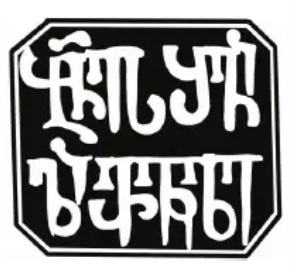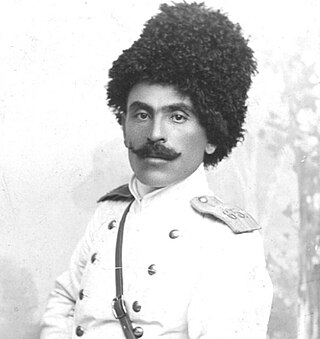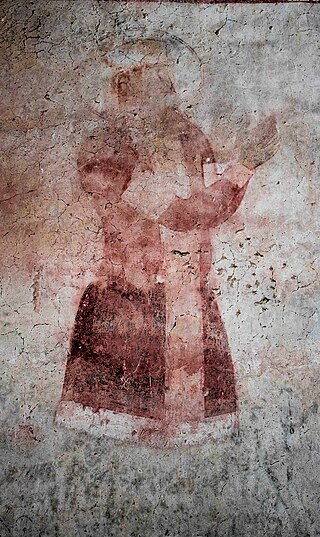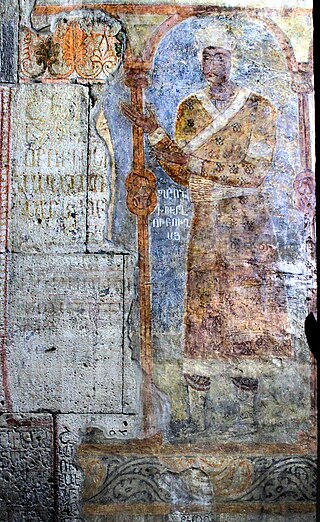
The court officials of the Kingdom of Georgia , were in charge of the royal court.
Contents
The chronological lists below are not exhaustive, since there exist large gaps in the historical record.

The court officials of the Kingdom of Georgia , were in charge of the royal court.
The chronological lists below are not exhaustive, since there exist large gaps in the historical record.
The majordomo (Georgian: msakhurtukhutsesi) was the chief official of the court.
| Name | First record in office | Final record in office | Title(s) |
|---|---|---|---|
| Apridon | 1178 | 1184 | |
| Vardan I Dadiani | 1185 | 1911 | |
| Ivane I Zakarian | 1191 | 1207 | |
| Vache I Vachutian | 1207 [2] | ? | |
| Vahram Gageli | 1212 | 1230 | |
| Manavel (son of Vache) | 1230 | 1245 | |
| Grigol Surameli | 1245 | 1260 | |
| Bega II Surameli | 1260 | 1280 | |
| Hamada Surameli | 1280 | 1290 |
The Chancellor (Georgian: mtsignobartukhutsesi ) was the head of the government.
| Name | First record in office | Final record in office | Title(s) |
|---|---|---|---|
| George of Chqondidi | 1105 | 1118 | |
| Svimeon | 1118 | 1140 | |
| John | 1179 | ||
| Anton Gnolistavisdze | 1177 | 1204 | |
| Michael IV of Georgia | 1184 | 1185/6 | |
| Theodore II of Georgia | 1204 | 1207 | |
| Arsen of Georgia | 1063 | 1248 | |
| Basil | 1250 | 1265 |
The treasurer (Georgian: mechurchletukhutsesi ) was the official responsible for running the treasury.

| Name | First record in office | Final record in office | Title(s) |
|---|---|---|---|
| Ivane III Vardanisdze | |||
| Ivane Kolonkelisdze | 1177/1178 | ||
| Qutlu Arslan | 1177 | 1185 | |
| Kakhaber Vardanisdze | 1185 | ||
| Abulasan | 1185 | 1188 | |
| Shalva Akhaltsikheli | 1212 | 1222 | |
| Shota Rustaveli | |||
| Ivane I Jaqeli | 1191 | 1247 | |
| Gamrekeli Toreli | 1241 | ||
| Mamucha | 1241/1242 | ||
| Kakha III Toreli | 1250s | 1270s |
The master of ceremonies (Georgian: Mandaturtukhutsesi ) was responsible for conducting ceremonies such as coronations and receptions of foreign ambassadors.

| Name | First record in office | Final record in office | Title(s) |
|---|---|---|---|
| Ivane III Vardanisdze | |||
| Ivane I Orbeli | |||
| Sumbat I Orbeli | 1155 | ||
| Ivane II Orbeli | 1160 | 1178 | |
| Kubasar | 1178 | 1184 | |
| Chiaber | 1185 | 1195 | |
| Zakare II Zakarian | 1195 | 1202/03 | |
| Shalva Akhaltsikheli | 1202/03 | 1215 | |
| Shahnshah Zakarian | 1223 | 1261 | |
| Avag-Sargis III Zakarian | 1261 | 1268 | |
| Ivane II Zakarian | 1268 | 1285 | |
| Beka I Jaqeli | 1285 | 1308 | |
| Sargis II Jaqeli | 1308 | 1334 |
The marshal (Georgian: amirspasalar ) had charge of the royal stables, i.e. "Commander-in-Chief" of the army.

| Name | First record in office | Final record in office | Title(s) |
|---|---|---|---|
| Ivane I Orbeli | 1128 | ||
| Sumbat I Orbeli | 1128 | 1155 | |
| Kirkash Abuletisdze | 1155 | 1156 | |
| Ivane II Orbeli | 1156 | 1178 | |
| Kubasar | 1178 | 1184 | |
| Sargis Zakarian | 1185 | 1187 | |
| Gamrekeli Toreli | 1187 | 1189 | |
| Chiaber | 1090 | 1091 | |
| Zakare II Zakarian | 1191 | 1212 | |
| Shahnshah Zakarian | 1212 | 1240 | |
| Avag Zakarian | 1242 | 1250 | |
| Zakare III Zakarian | 1250 | 1262 | |
| Ivane III Abuletisdze | 1260 | 1272 | |
| Sadun of Mankaberd | 1272 | 1281/1282 | |
| Khutlubuga | 1289 | 1293 | |
| Mkhargrdzeli (son of Shanshe I) | 1285 | ||
| Shahnshah II Zakarian | 1290 | 1310 | |
| Qvarqvare I Jaqeli | 1334 | 1361 | |
| Aghbugha I Jaqeli | 1361 | 1391 |
The tutor (Georgian: atabeg) came to be denominated as Samtskhe-Saatabago, the latter element meaning "of the atabags". [5]
| Name | First record in office | Final record in office | Title(s) |
|---|---|---|---|
| Ivane I Zakarian | 1207 | 1227 | |
| Avag Zakarian | 1227 | 1250 | |
| Zakare III Zakarian [6] | 1250 | 1260 | |
| Ivane III Abuletisdze | 1260 | 1272 | |
| Sadun of Mankaberd | 1272 | 1281/1282 | |
| Tarsaich Orbelian | 1284 | 1289 | |
| Mkhargrdzeli (grandson of Shanshe I) | 1285 | ||
| Khutlubugha [7] | 1292 | 1293 | |
| Shahnshah II Zakarian [7] | 1294 | 1306 | |
| Sargis II Jaqeli [7] | 1306 | 1334 | |
| Aghbugha I Jaqeli | 1361 | 1391 |
Shahnshah , of the Zakarian family. Though we don't have documental informations concerning the paintings of the Aisle , the portraits of the donators whom we consider to be Shahnshah and his wife allow us to look upon the painting as one close to the date of the Big Church ; the likeness in the artistic style confirms this suggestion

Batonishvili is a title for royal princes and princesses who descend from the Kings of Georgia from the Bagrationi dynasty.

Giorgi Mazniashvili was a Georgian general and one of the most prominent military figures in the Democratic Republic of Georgia.

Demetrius I, from the Bagrationi dynasty, was King (mepe) of Georgia from 1125 to 1156. He is also known as a poet. He was King of Georgian kingdom two times, first in 1125 to 1154 and second in 1155 before his death in 1156.
David V, of the Bagrationi dynasty, was a 7th king (mepe) of Georgia in 1154 before his death in 1155.

David VII, also known as David Ulugh (1215–1270), from the Bagrationi dynasty, was king (mepe) of Georgia from 1246 to 1270. He first ruled Georgia jointly with his namesake cousin, David VI, from 1246 to 1259. From 1259, David VI, revolting from the Mongol hegemony, seceded in the western half of the kingdom and formed the Kingdom of Western Georgia, while David VII was left to rule a reduced Kingdom of Georgia (1256–1329) in the region of eastern Georgia under Mongol control.
David IX, from the Bagrationi dynasty, was king (mepe) of Georgia from 1346 until his death.

The Zakarid dynasty, also Zakarids or Zakarians were a noble Armenian dynasty, rulers of Zakarid Armenia (1201–1350) under the suzerainty of the Kingdom of Georgia, and from 1256 under the control of the Mongol Ilkhanate of Persia. Their dynastic name was formed in honour of Zakare, the famous servant of the Georgian Queen Tamar. They were also known by their Georgian nickname Mkhargrdzeli. A family legend says that this name was a reference to their Achaemenid ancestor Artaxerxes II the "Longarmed". According to Cyril Toumanoff / Encyclopædia Iranica, they were an offshoot of the Armenian Pahlavuni family. The Zakarians considered themselves Armenians.

The Peace of Amasya was a treaty agreed to on May 29, 1555, between Shah Tahmasp I of Safavid Iran and Sultan Suleiman the Magnificent of the Ottoman Empire at the city of Amasya, following the Ottoman–Safavid War of 1532–1555.

Arghun Agha, also Arghun Aqa or Arghun the Elder was a Mongol noble of the Oirat clan in the 13th century. He was a governor in the Mongol-controlled area of Persia from 1243 to 1255, before the Ilkhanate was created by Hulagu. Arghun Agha was in control of the four districts of eastern and central Persia, as decreed by the great khan Möngke Khan.

Zakarid Armenia alternatively known as the Zakarid Period, describes a historical period in the Middle Ages during which the Armenian vassals of the Kingdom of Georgia were ruled by the Zakarid-Mkhargrzeli dynasty. The city of Ani was the capital of the princedom. The Zakarids were vassals to the Bagrationi dynasty in Georgia, but frequently acted independently and at times titled themselves as kings. In 1236, they fell under the rule of the Mongol Empire as a vassal state with local autonomy.
The Apsilae or Apsili were an ancient tribe inhabiting the territory of Apsilia, in modern Abkhazia.
Sargis II Jaqeli was a Georgian prince (mtavari) and ruler of Principality of Samtskhe from 1306 to 1334. He was a son of Prince Beka I Jaqeli. During his father's reign Sargis participated in many campaigns. In 1290s Azat Mousa, leader of the Anatolian Turkoman tribes, attacked Samtskhe. Beka Jaqeli appointed Sargis as a commander of army and ordered him to stop Turks near village Vashlovani. Around 1303, Sargis defeated Turkoman tribes and expelled them from Meskhetian lands. In 1306, after his father's death, Sargis ascended the Atabeg's throne. He was made Amirspasalar and Atabeg of the Kingdom of Georgia by his nephew, King George V "the Brilliant". After Sargis II's death, his son Qvarqvare became a new Prince of Meskheti, also the vassal of Georgian kingdom.
Balendukht or Balendokht was a Sasanian princess and queen consort of Iberia. She was the daughter of Sasanian shah (king) Hormizd III. During her youth, she married Vakhtang I, the ruler of Iberia, with whom she had one child named Dachi. Balendukht, however, died in childbirth.
Kukaracha is a 1982 Georgian film directed by Siko Dolidze and Keti Dolidze. It is based on a story by Nodar Dumbadze
Anastasia Virsaladze née Abdushelishvili, Georgian: ანასტასია ვირსალაძე, was a Georgian concert pianist and music teacher. In 1921, she began to teach at the Tbilisi Conservatory. Promoted to professor in 1929, she remained there until her retirement in 1966, teaching over 100 pianists. Among her most prominent students were Dmitri Bashkirov, Lev Vlassenko and her own granddaughter Eliso Virsaladze.

Originating in Abkhazia, the Shavliani Dynasty was a group of Egrisian lords who became so powerful that they even faced off against the royal dynasty. They usurped power after George I died, installing John Shavliani as king until his death, when his heir Adarnase succeeded him. During Adarnase's reign, Megrelian nobles and Byzantines who remained faithful to Bagrat I wished to overthrow Adarnase in his conflicts against the Armenians. But after Adarnase lost the Battle of Kutais, the dynasty withdrew to Racha-Lechkhumi and Kvemo Svaneti, where they took on new surnames to avoid being persecuted. Adarnase died as a result. Inscriptions found in local churches attest to the affection the people of Khoni had for the rulers, who owned estates in the Khoni Municipality's Nakhakhulevi and Kukhi.

Sadun Artsruni, also Sadun of Mankaberd of the House of the Artsrunids, was an Armenian prince, Prince of Haghbat and Mankaberd. He was a court official and became Atabeg and Amirspasalar of the Kingdom of Eastern Georgia, and later chamberlain of Avag's daughter Khoshak. He was concurrently "Prime Minister" of the Mongol Il-Khan Abaqa.

The Kingdom of Georgia from 1256 to 1329, sometimes called the Kingdom of Eastern Georgia was the official prolongation of the Kingdom of Georgia from 1256 to 1329, but limited in its rule to the geographical areas of central and eastern Georgia, while the western part of the country temporarily seceded to form the Kingdom of Western Georgia under its own line of kings. The secession followed a transitional period when the rule of the Kingdom of Georgia was jointly assumed by the cousins David VI and David VII from 1246 to 1256. The entity split into two parts when David VI, revolting from the Mongol hegemony, seceded in the western half of the kingdom and formed the Kingdom of Western Georgia in 1256. David VII was relegated to the rule of Eastern Georgia. During his reign, Eastern Georgia went into further decline under the Mongol overlordship.